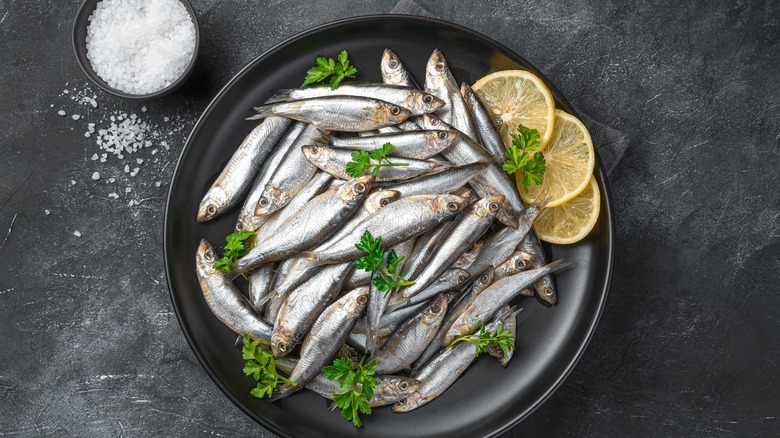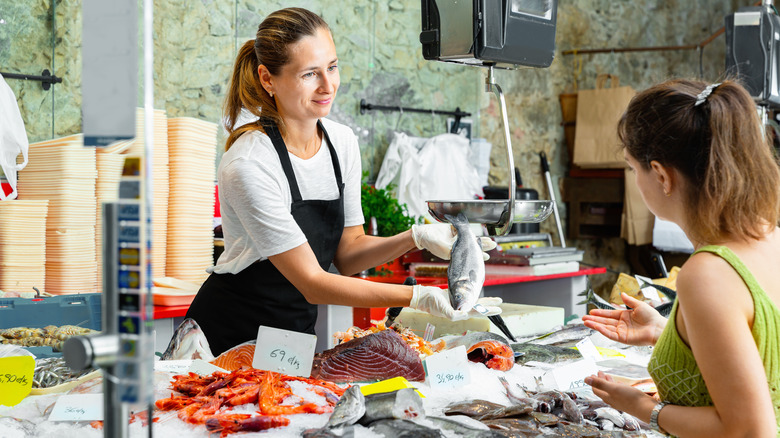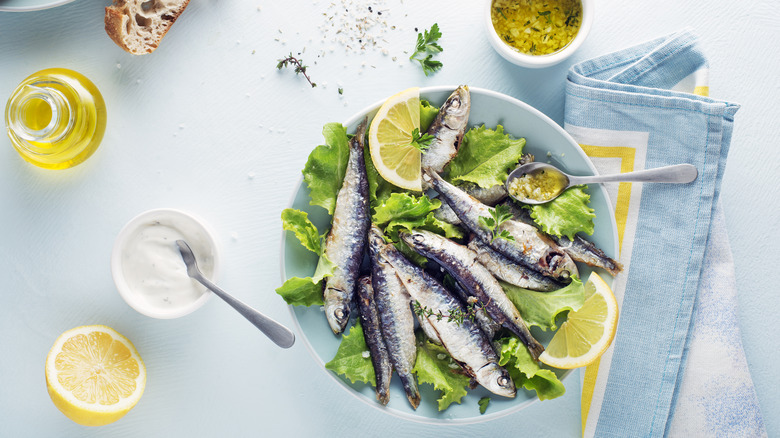Does Your Recipe Call For Fresh Sardines? Here's How To Choose The Best
It needs to be said: Fresh sardines are one of the most underrated fish to eat. One consequence of this is that they're usually very affordable, but another, less desirable result of their lack of popularity is that many people aren't entirely sure how to cook these scrumptious fish — let alone how to choose them!
In reality, top chefs have always known about the culinary potential of fresh sardines. They're by no means a humble offering: Gordon Ramsay uses fresh sardines in his recipes. But the knowledge of what to look for in choosing the best fresh sardines is a different skill entirely.
Sardines are smaller and lower in the food chain than the most popular fish we usually eat. However, the principles of what to look for when choosing fresh fish are generally similar across the species. If you're not confident you can remember all the detailed things to look for, there's one simple tip to ensure you buy fresh fish every time: Use your nose! Sardines are a high-oil fish, which means they do naturally have a stronger smell than some other fish, but this isn't a bad smell if they're fresh. If your nose detects something very strong or off-smelling, it's best to trust what it's telling you. You can also check the eyes of the sardines, which should not have gone cloudy yet.
More tips for choosing the best fresh sardines
There are plenty of red flags to look for when buying fish, so if you can, find a good fishmonger and get to know them. If the fishmonger doesn't know when the fish you're interested in arrived, or they tell you it's more than a day old, it may be best to steer clear. An important physical detail when identifying fresh sardines is the gill color. Bright red or pink indicates lots of blood in the gills, meaning it's still very fresh. A darker color of gill, especially brown or even green, and that fish is getting pretty old. However, this gill method works best with larger species of fish. With fresh sardines, it's more useful to check the skin and flesh — you're looking for silvery skin and firm flesh. Anything mushy is a bad sign.
The size of fresh sardines can vary quite a lot, so you can buy more or less depending on how large they are. Smaller sardines are great for covering with a little flour, frying in oil, and eating in big batches. However, smaller fish will spoil more quickly than larger ones, so if you're not planning to use them immediately, look for ones that are on the medium or larger side. Larger sardines are best cooked simply on the grill with a little oil. Once cooked, adding a dash of acid is all you need to totally elevate sardines.
The many reasons to eat fresh sardines
What if you have all the information you need to choose and cook fresh sardines, but you're simply not all that excited about the idea? For those who need more convincing, there is a long and varied list of reasons they're a great choice for home cooking.
Whether fresh or canned, sardines are a nutritional powerhouse, high in protein and packed with omega-3 fatty acids, as well as vitamins D, B-12, and calcium. Sardines are also low in mercury by comparison to many other fish and are a safe choice for pregnant and nursing women. On top of this, fresh sardines are often a sustainable choice to eat, just look for an MSC (Marine Stewardship Council) certification logo on tinned or packed fresh sardines sold in stores.
One of the greatest reasons to cook with fresh sardines is that they're delicious! When cooked right, their texture and delicate flavor are truly satisfying, especially when combined with simple ingredients like fresh chopped parsley, lemon, olive oil, and salt. The distinctive fishiness of canned sardines isn't for everyone — but fresh sardines don't have that intensity, and when cooked right, their texture and delicate flavor are truly delicious. Especially considering they're also one of the least expensive fish, fresh sardines are a great choice for home cooking.


